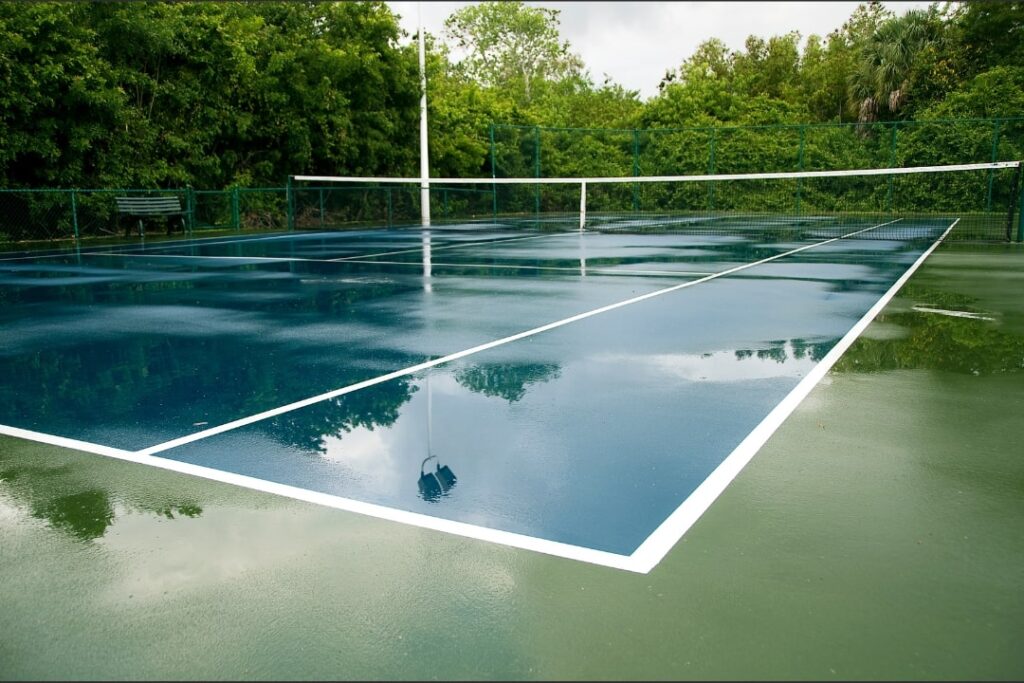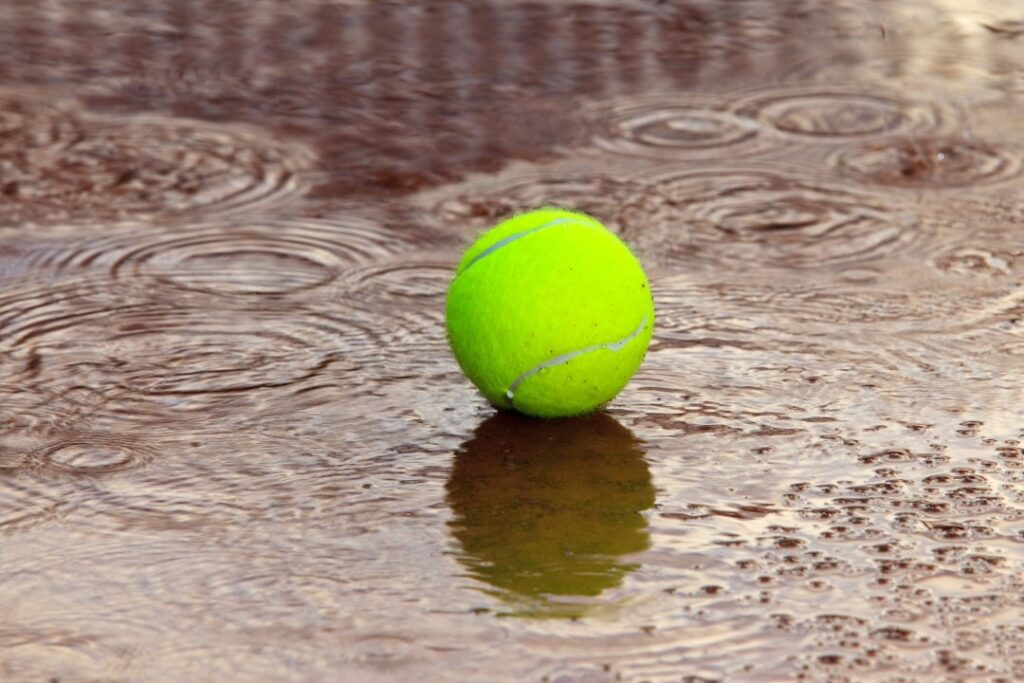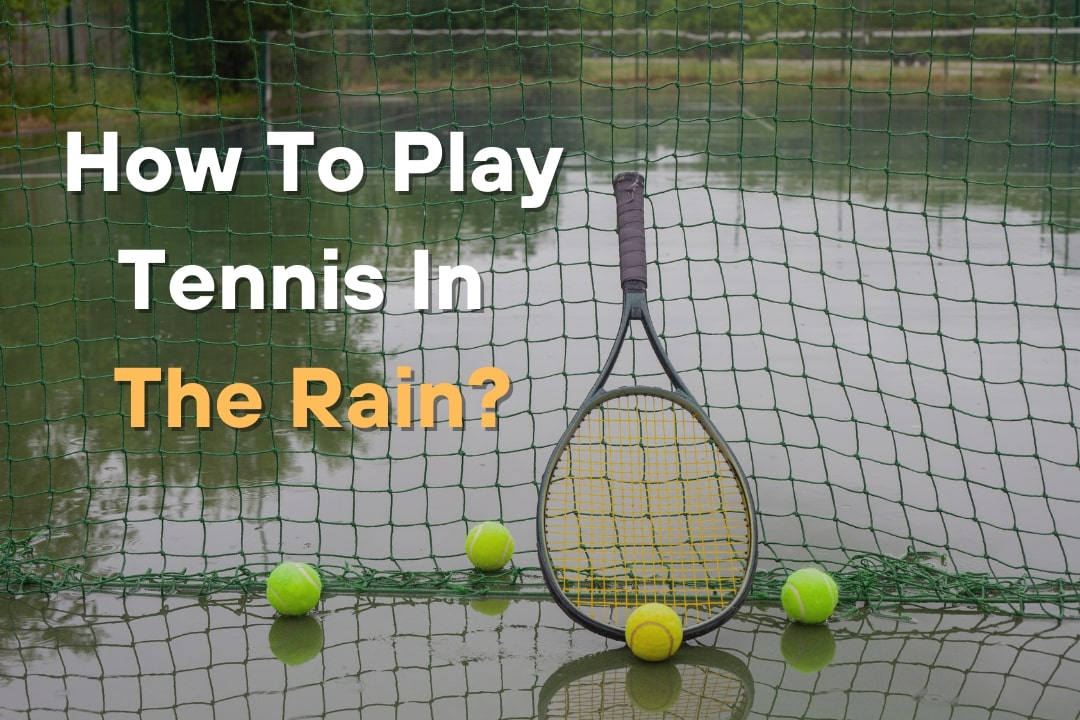So you are playing tennis outside, and then rain suddenly pours down. Rain is a natural condition that can’t be avoided if you are outdoors. So, what happens if there is rain and the court is wet when we play tennis?
Can you play tennis in the rain?
Yes, you can play tennis in the rain, but it depends on how wet the court is. You can still play tennis freely in a light rain or a drizzle. If there is heavy rain, it is not advisable to play. The wet court surfaces make players easily lose their footing and slip, leading to injuries.
Let’s look at how different tennis court surfaces change with rain, what water does to tennis balls, and how to speed up the drying process of a wet court. Read along to learn more!
Table of Contents
Can You Play Tennis On a Wet Court?

Tennis is usually played on three court surfaces: grass, clay, and hard courts. Tennis can still be played in the rain, depending on the court surface.
Clay Court
Some water is regularly poured into clay courts for maintenance, even without rain.
You can still play on clay courts when there is light rain. The clay absorbs water and makes the surface soft and slippery, but it will still be usable if there is not too much water.
The problem comes when heavy rain comes, and the clay court absorbs too much water. The clay will become muddier the more water it absorbs.
The muddy court is dangerous for players as it is more slippery and sticky, resulting in players occasionally falling and not playing tennis properly.
The muddy court will also affect the ball’s bounce and speed. A wet clay court can drastically slow down the ball and make it stick to the ground.
Matches on clay courts are usually stopped at the first sign of rain and can only be resumed once the court is dry and in playable condition.
Hard Court
Hard courts are made from rigid materials like concrete and asphalt, which do not absorb water.
To know if a hard court is still usable in the rain, you just have to judge it based on the amount of puddles that formed.
In light rain, usually, there are no big puddles. Yes, the court will be slippery, but it is still usable for playing tennis.
In case of heavy rains, there will be large rainwater puddles forming in some areas of the court. The puddles make the court unusable because the ball cannot bounce if it hits the puddles.
Even if you are still forcing yourself to play tennis in heavy rains, it will not be fun since the balls will keep drowning in the puddles.
Grass Court
By nature, grasses become slick and slippery when there is rain. Whether it is a light or heavy rain, the grass will become wet all the same.
Due to this nature, the grass court is the hardest to play in rainy conditions. It will be difficult for players to maintain their footing on the slippery grass, resulting in them slipping off often and increase risk of injury.
The ball tends to bounce unpredictably on wet grass surfaces, making it more challenging for players to predict and react to shots.
Therefore, the grass court is unsuitable for tennis during light or heavy rain.
How to Dry a Wet Tennis Court?
Since the water is absorbed in clay and grass courts, you have to naturally wait for the wet court to dry by itself. No tool can help in drying wet clay and grass courts.
During the daytime, when there is sun, it will speed up the process. In contrast, it will take longer to dry during nighttime.
For hard courts, the water is not absorbed but stays as puddles in the court. So, you can use tools such as a rolling squeegee to push water off the court. Do this repeatedly until all the puddles are gone.
However, the tool will only partially dry the court, especially if there is a lot of water. If there is still part on the court that won’t dry off, use an old tower or rag to absorb the residue. Then, wait a little bit for the court to dry off naturally.
How Fast Do Tennis Courts Dry After Rain?
Suppose you just wait naturally without doing anything. In that case, a tennis court can take 30 to 90 minutes to dry from a light rain.
When the rain is heavy, it will take 2-3 hours on average to dry during the day. Naturally, it will take longer with no sunlight.
The grass court will take the longest to dry completely, even if it is only caused by drizzles.
Using a rolling squeegee to remove all water in hard courts can take 5-10 minutes for a few small puddles and 15-25 minutes for very wet courts.
Tips for Playing Tennis in the Rain
Note that these tips only apply to light rain. If the rain is too heavy or the court gets too wet, wait until the rain calms down before using the court to avoid unnecessary injuries.
With that being said, here are some tips to utilize when playing tennis in the rain:
Optimize your Tennis Gear
You can’t use your standard tennis gear when you play tennis in the rain unless you want to injure yourself. These are some essential gear to consider when you play tennis in the rain:
- Use tennis shoes that are waterproof and have good traction to minimize slipping and fall.
- Use a rain jacket or waterproof coat, as the weather can be cold when it rains.
- Use a hat to protect your head from the rain and prevent water from flowing into your eyes.
- Overcoat your racket grip with an overgrip that is secure and not slippery.
- If you are not playing in official tournaments, use balls that are not brand new, as water will damage the ball permanently.
Bring Extra Towels
During rain, naturally, your body and face will be wetter. Bringing more towels is always a good idea in case one gets too wet.
To maximize the ball performance of each play, you can use towels to wipe off wet balls before each serve.
Towels can also be used to wipe off residual water in hard courts after using the rolling squeegee, to speed up the drying process.
Be Aware of Your Movement
When you run in the rain, your balance will be hindered. So, running at 100% speed or moving too quickly will make you fall very easily.
Keep your feet close to the ground and take shorter steps when running to improve balance and prevent slipping.
Of course, your speed will get affected, but so does your opponent. Sliding is also a great technique to reach the ball faster and have a balanced footing.
Avoid puddles or area that has more water than the rest.
Adjust Your Playstyle
A topspin in a regular dry court causes the ball to bounce higher, but this is not the case on wet surfaces. Wet surfaces make the ball heavier and bounce lower than usual.
Because of this, topspin and kick serves will be less effective on wet surfaces, as the ball will bounce at the point where the opponent easily returns it. So, you need to change your playstyle.
Stick to slices and aim to hit the ball lower. This can be achieved by bending your knees more.
The lower ball will bounce even lower from the extra weight, resulting in a difficult shot for your opponent to return.
Using more volleys and net play over groundstrokes is also a good strategy since you can save energy and avoid running to avoid slipping.
Effect of Water in Tennis Balls: Can You Play Tennis With Wet Balls?

Yes, you can play tennis with wet balls, but it will have a lower quality in performance if compared to regular tennis balls.
When exposed to rain, the fabric covering a tennis ball absorbs water, causing it to become heavier and less bouncy.
The extra weight from the absorbed water slows down the ball, making it unable to bounce as high and travel far.
For example, a topspin that usually results in a high bounce ball will become far less bouncy and become easier for the opponent to return the shot.
To minimize the damage, immediately dry the balls after use. You can dry it in the sun or do it manually with a hairdryer. Most of the water will come out when you dry it, but there will always be some left, and it can’t return 100% back to normal.
The lifespan of the ball will be affected. The absorbed water will result in permanent loss of bounce and quality.
It will still be able to be used in casual games or practice. But it won’t be ideal for competitive matches or training.
So, if you want to play tennis in the rain, use balls that you are okay with losing. Do not use brand new balls.
Tennis in the Rain Rules: What Do Professionals Tournament Do When It Rains?
The officials will declare a rain delay if heavy rain occurs during a professional tennis tournament.
During rain delays, players will take a short break until the rain stops. They can stay inside the locker room or the courtside that are safe from rainfall..
After the rain has stopped and the court has been dried off, players will resume the match.
It is possible for the tournament to have an indoor court or a court with a roof cover. In that case, they can be an alternative court for the match.
If several matches have already been delayed by more than an hour and the rain has not stopped, the match may be suspended into another time.
Also, there will be some cases when there is an extreme weather forecast at the scheduled time of the match. In this case, some tournaments allow players to mutually agree to cancel a match before it starts, and no score is officially recorded.
If the rain is just light drizzles, the match will still continue.
Wrapping Up
While playing tennis on a wet court and rain is still doable, remember that safety is always the top priority. If it is just a light rain or drizzles, you can play tennis openly.
However, in case of heavy rain, you should wait until the rain stops and dry the court before using it.
Balls get wet due to exposure of rain and it will be permanently damaged.
Playing tennis in the rain is a challenge, so if you can adapt your game to any conditions, you will increase your tennis level!
Related Questions
Does Rain Ruin Tennis Balls?
Yes, tennis balls exposed to rain become wet and have reduced quality compared to regular balls. Even though it can still be used for casual play, the water inside the ball will make it heavier, slow it down, and become less bouncy. A wet ball cannot go back to its standard form.
Do Tennis Balls Bounce on Water?
Tennis balls can still bounce on wet surfaces but will have a lower bounce than on dry surfaces. Balls are not able to bounce in deep water puddles or muddy clay court. If a court has many areas with puddles, it needs to be dried first before balls can consistently bounce in the court.
Are Tennis Balls Waterproof?
Tennis balls are not waterproof, but some are designed to dry off quickly. A tennis ball can’t be exposed to water, as the fabric can absorb water. The absorbed water will ruin the ball permanently.
Is it Safe to Play Tennis in Thunderstorms?
No, it is not safe to play tennis in thunderstorms. You can get injured easily by slipping off the court. You can’t play tennis normally, since the balls will become wet and fly around due to heavy wind. You will also be unable to see properly, which can be dangerous.

